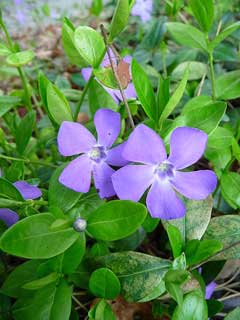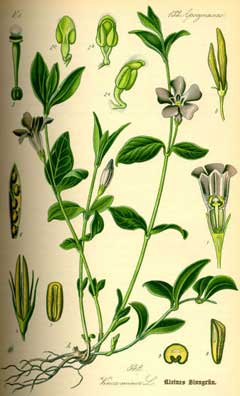 |
|
commons.wikimedia.org/wiki/User:4028mdk09 |
 |
| commons.wikimedia.org/wiki/File:Illustration_Vinca_minor0.jpg |
Translate this page:
Summary
Bloom Color: Blue, Lavender, Purple, White. Main Bloom Time: Early summer, Early spring, Late spring, Mid spring. Form: Prostrate, Spreading or horizontal, Variable spread.
Physical Characteristics

 Vinca_minor is an evergreen Shrub growing to 0.2 m (0ft 8in) by 1 m (3ft 3in) at a medium rate.
Vinca_minor is an evergreen Shrub growing to 0.2 m (0ft 8in) by 1 m (3ft 3in) at a medium rate.
See above for USDA hardiness. It is hardy to UK zone 4 and is not frost tender. It is in leaf all year, in flower from April to May. The species is hermaphrodite (has both male and female organs) and is pollinated by Bees.
Suitable for: light (sandy), medium (loamy) and heavy (clay) soils and can grow in heavy clay soil. Suitable pH: mildly acid, neutral and basic (mildly alkaline) soils. It can grow in full shade (deep woodland) semi-shade (light woodland) or no shade. It prefers dry or moist soil and can tolerate drought.
UK Hardiness Map
US Hardiness Map
Synonyms
Pervinca heterophyla. Pervinca minor. Pervinca procumbens. Vinca acutiflora . Vinca ellipticifolia.
Plant Habitats
Edible Uses
References More on Edible Uses
Medicinal Uses
Plants For A Future can not take any responsibility for any adverse effects from the use of plants. Always seek advice from a professional before using a plant medicinally.
The plant is sedative and tonic[21, 53, 165]. It contains the alkaloid 'vincamine', which is used by the pharmaceutical industry as a cerebral stimulant and vasodilator[238]. Since the discovery of vincamine in the leaves, the plant has been used herbally to treat arteriosclerosis and for dementia due to insufficient blood supply to the brain[254]. The leaves are bitter, detergent and stomachic[7]. Taken internally, they are used in the treatment of internal bleeding, heavy menstrual bleeding and nosebleeds[254]. When crushed and applied to wounds they have astringent and healing properties[7]. A mouthwash is used to treat gingivitis, sore throats and mouth ulcers[254]. The leaves are gathered in the spring and dried for later use[7]. The root is antispasmodic and hypotensive[7, 19]. It is used to lower the blood pressure[19]. The root is gathered in the autumn and dried for later use[7]. The fresh flowers are gently purgative, but lose their effect on drying[4]. A homeopathic remedy is made from the fresh leaves[4]. It is used in the treatment of haemorrhages[4].
References More on Medicinal Uses
The Bookshop: Edible Plant Books
Our Latest books on Perennial Plants For Food Forests and Permaculture Gardens in paperback or digital formats.

Edible Tropical Plants
Food Forest Plants for Hotter Conditions: 250+ Plants For Tropical Food Forests & Permaculture Gardens.
More

Edible Temperate Plants
Plants for Your Food Forest: 500 Plants for Temperate Food Forests & Permaculture Gardens.
More

More Books
PFAF have eight books available in paperback and digital formats. Browse the shop for more information.
Shop Now
Other Uses
The stems are used in basket making[7]. A very good ground cover for covering steep banks and shady places, spreading rapidly once established and forming a dense cover within 2 years[11, 28, 31, 190, 200]. It is less dense on dry or exposed sites[197]. Plants are best spaced about 60cm apart each way[208].
Special Uses
References More on Other Uses
Cultivation details
Landscape Uses:Border, Container, Erosion control, Ground cover, Massing, Specimen. A very easily grown plant, it succeeds in almost any soil[200] but prefers those that are on the richer side[17]. It grows well in heavy clay soils. Plants are very shade tolerant but they do not flower so well in deep shade[11, 28, 31]. It grows well under deciduous trees[187], and in such a position it can succeed in dry soils[190]. Established plants are drought tolerant[190]. A very ornamental[1] and polymorphic plant[200], there are some named forms selected for their ornamental value[187]. Members of this genus are rarely if ever troubled by browsing deer or rabbits[233]. This species rarely if ever sets seed in Britain[4]. It spreads rapidly by long trailing and rooting stems once it is established and will swamp out smaller plants[4]. Special Features:Attractive foliage, Not North American native, Naturalizing, Attractive flowers or blooms.
References Carbon Farming Information and Carbon Sequestration Information
Temperature Converter
Type a value in the Celsius field to convert the value to Fahrenheit:
Fahrenheit:
The PFAF Bookshop
Plants For A Future have a number of books available in paperback and digital form. Book titles include Edible Plants, Edible Perennials, Edible Trees,Edible Shrubs, Woodland Gardening, and Temperate Food Forest Plants. Our new book is Food Forest Plants For Hotter Conditions (Tropical and Sub-Tropical).
Shop Now
Plant Propagation
Seed - we have no information on this species but suggest sowing the seed in a cold frame as soon as it is ripe if possible. Sow stored seed in late winter in a cold frame. When they are large enough to handle, prick the seedlings out into individual pots and grow them on in the greenhouse for their first winter. Plant them out into their permanent positions in late spring or early summer, after the last expected frosts. Division in spring just before active growth commences[78], or in autumn[1]. Larger divisions can be planted out direct into their permanent positions. We have found that it is best to pot up smaller divisions and grow them on in light shade in a greenhouse or cold frame until they are growing away well. Plant them out in the summer or the following spring. Cuttings of mature wood of the current seasons growth, 5 - 10 cm long, October in a cold frame. Roots quickly. High percentage[78].
Other Names
If available other names are mentioned here
Native Range
TEMPERATE ASIA: Turkey EUROPE: Austria, Belgium, Switzerland, Czech Republic, Germany, Hungary, Netherlands, Poland, Slovakia, Lithuania, Latvia, Moldova, Russian Federation (Kaliningrad), Ukraine (Krym), Bulgaria, Greece, Croatia, Italy (incl. Sicily), Romania, Serbia, Slovenia, Spain, France (incl. Corsica), Portugal
Weed Potential
Right plant wrong place. We are currently updating this section.
Please note that a plant may be invasive in one area but may not in your area so it’s worth checking.
Conservation Status
IUCN Red List of Threatened Plants Status :

| Related Plants
|
| Latin Name | Common Name | Habit | Height | Hardiness | Growth | Soil | Shade | Moisture | Edible | Medicinal | Other |
| Vinca minor | Lesser Periwinkle, Flower of Death, English Holly, Creeping Myrtle, Creeping Vinca, Common Periwink | Shrub | 0.2 |
4-9
| M | LMH | FSN | DM | 0 | 3 | 3 |
|
Growth: S = slow M = medium F = fast. Soil: L = light (sandy) M = medium H = heavy (clay). pH: A = acid N = neutral B = basic (alkaline). Shade: F = full shade S = semi-shade N = no shade. Moisture: D = dry M = Moist We = wet Wa = water.
Expert comment
Author
L.
Botanical References
1117200
Links / References
For a list of references used on this page please go here
Readers comment